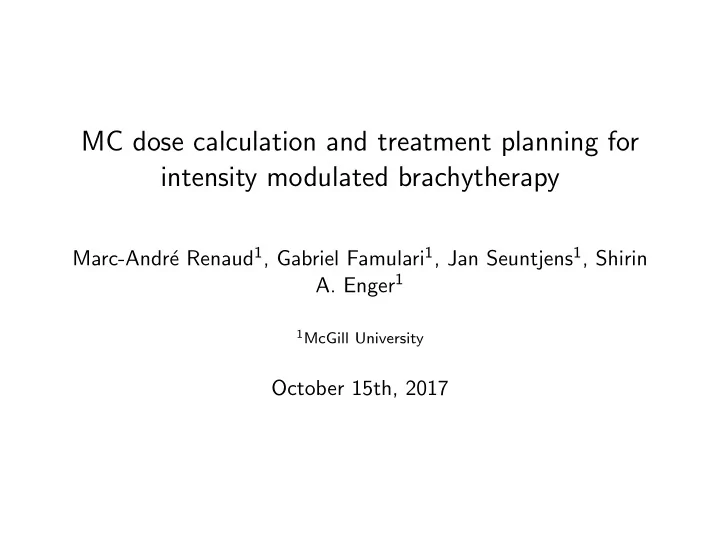

MC dose calculation and treatment planning for intensity modulated brachytherapy e Renaud 1 , Gabriel Famulari 1 , Jan Seuntjens 1 , Shirin Marc-Andr´ A. Enger 1 1 McGill University October 15th, 2017
Rotating shield brachytherapy Intensity modulated brachytherapy (IMBT) is a form of brachytherapy using shielded rotating catheters for use in interstitial, intercavitary and interluminal brachytherapy treatments. Figure: Model of the microSelectronV2 source geometry with added platinum rotating shield. ◮ Active core: 0.325 mm radius, 3.6 mm length ◮ Including shield: 0.8 mm radius
Isodose distributions Platinum shield with 0.8 mm maximum thickness: Figure: Relative dose rate distributions shown in a plane perpendicular to the source axis of a shielded microSelectron source with a modified active core. Normalized to 100% at 1 cm off-axis (shown as a dot).
BrachySource BrachySource: a Geant4-based user code for IMBT dose calculations. ◮ Uses PENELOPE low energy EM physics. ◮ Can account for density and composition heterogeneities of all components (applicator, patient, etc) involved in the dose calculation. ◮ Library of source geometries (such as microSelectronV2 and FlexiSource). ◮ Active core can be replaced by any isotope in macro file at runtime. The particle source is modelled starting from nuclear decay.
Optimisation Figure: Dwell position selection For every dwell position, dose distributions for 16 shield angles generated (every 22.5 degrees rotation). Typical prostate case: ≈ 2000 position/angle combinations.
Cost function | S | | S | ( f − � � si + f + F i = F s = si ) s =1 s =1 f − si = max (0 , T s − D i ) 2 si = max (0 , D i − T s ) 2 f + minimize F ( D i ) subject to the constraints � t j D ij = D i j ∈ J where t j is the dwell time at position j and D ij is the unit-time dose to voxel i from dwell position j.
Optimisation workflow Treatment plan creation is performed iteratively. Given the current treatment plan: 1. Out of all possible dwell position and shield angle combinations, identify the one that will most improve the cost function 2. Add the dwell position to the treatment plan and optimise the dwell times to minimise the cost function 3. Repeat step 1 until cost function can no longer be improved or a user-selected convergence criteria has been met
Identifying good dwell positions Column generation in words: ◮ Optimise current treatment plan to convergence (starting with an empty treatment plan with 0 dose initially) ◮ Differentiate the cost function with respect to the current value of dose in each voxel. π i = − ∂ F (1) ∂ D i ◮ For each dwell position and shield angle combination not included in the plan: ◮ Calculate the “price” of adding the dwell position j, N v � P = (2) D ij π i i =1 ◮ Dwell position and shield angle with the largest price gets added to the treatment plan.
Example IMBT treatment plan Figure: Dose volume histogram comparing shielded 153 Gd to unshielded 192 Ir.
Example IMBT treatment plan Figure: (left) Shielded Gd-153, (right) Unshielded Ir-192
Cost evolution 60 Current cost Asymptotic cost 50 Cost function value 40 30 20 10 0 0 50 100 150 200 250 300 350 Num. DPSA
Conclusions ◮ Column generation provides a method for selecting useful dwell positions out of a large pool of candidates. ◮ IMBT plans provide increased OAR sparing without sacrificing PTV coverage. ◮ Practical issues remain such as inter-source attenuation and delivery times depending on choice of isotope.
Acknowledgements The authors acknowledge partial support by the CREATE Medical Physics Research Training Network grant of the Natural Sciences and Engineering Research Council (Grant number: 432290), along with the Fonds de Recherche du Qu´ ebec - Nature et technologies (FRQNT).
Recommend
More recommend